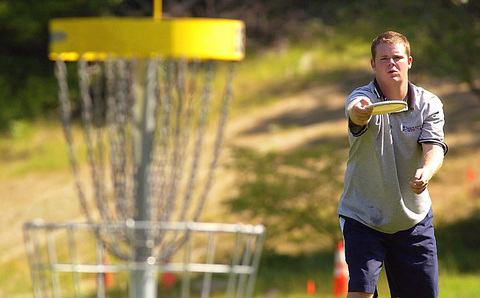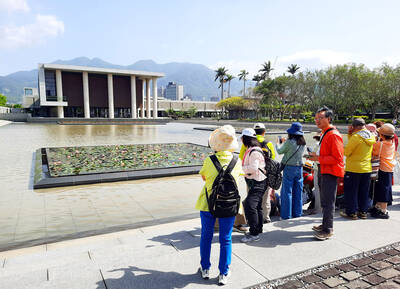When Steve Rico's shot caromed off a maple on the par-3 14th hole, he walked up to the nearest tree trunk and started kicking it. He'd already sworn, stomped and had a testy exchange with the tournament gallery earlier in the round. Now he was just standing there, kicking a tree.
Golf was laying claim to yet another man's sanity.
True, this was disc golf, but its damaging effect on the psyche was no different from that of the traditional variety. Rico was one of 300 professional disc golfers who came to the Lehigh Valley in Pennsylvania in late July to compete in the 24th annual Pro Disc Golf World Championships. Conducted on four of the state's 31 disc golf courses, the tournament had drawn such disc golf greats as Dave Feldberg, Des Reading, Barry Schultz and Juliana Korver -- all household names, if you happen to live in a household where nicked discs hanging from your walls count as interior decorating.

PHOTO: NY TIMES
Invented in the mid-1970s, disc golf is regular golf's poor cousin. The top prize in the most competitive men's division at the Worlds was US$5,000 (each golfer paid a US$180 entrance fee, out of which the prize money was rationed), and the spectator galleries rarely swelled to more than half a dozen until the last day of the six-day tournament.
The sport is based on traditional golf (or ball golf, as practitioners of the disc game call it), in that players negotiate a 9-, 18- or 27-hole courses by using the fewest number of throws and tallying up their score at the end. A disc golf "hole" is actually a metal basket sitting halfway up a pole; from the top of it hang metal chains that provide a target for the thrower. A disc hitting the chains the right way will drop into the basket with a distinctive ching.
In disc golf's infancy, lampposts, trees or other fixed objects were used as holes, but the invention of the basket by Ed Headrick "brought finality to each hole and professionalism to the sport," according to Jim Davis, known as Rocco, a Worlds tournament director. Headrick, the founder of formal disc golf and the designer of the "modern" Frisbee for Wham-O in 1964, is still a regular presence at disc golf courses -- his cremated remains were pressed into several thousand discs after his death three years ago.
Back at Nockamixon State Park, the most treacherous of the four Allentown-area courses being used for the Worlds this year, the 11-time world champion Ken Climo was peering down the fairway at a waving figure. "Is he giving us the all clear or is he going to the bathroom?" he asked. A few moments later, Climo gave a shrug and, with a hop-step off the rubber tee pad, launched his disc. "Cabbage!" he yelled as it veered off course and disappeared into the foliage. An errant shot into the woods is usually called "salad bar" by disc golfers, and is considered a good thing only when it becomes a "drive-through salad bar" by re-emerging safely and landing in the fairway, which Climo's shot decidedly did not.
Climo, a lanky, immensely broad-shouldered Floridian known simply as the Champ, has been a full-time disc golfer for 17 years, and with over US$260,000 in prize money, he is by far the career earnings leader. Sponsorships and bonus money paid by companies like the disc maker Innova double his yearly take. And yet being the greatest player ever to heave a golf disc is not unlike being the king of Tuvalu -- your subjects revere you, but the world at large is oblivious to your achievements.
"Sure I get frustrated at seeing all the off-the-wall sports that are televised, get the crowds and earn big money," Climo said. "Watching a bowling skills competition with a US$20,000 prize? Bass fishing? Come on."
Climo, who is among a small group of
players on the nine-month-long Pro Disc Golf Association tour, does what he can to promote the sport. In June, he and seven other golfers appeared at a Triple-A baseball game in Des Moines to hurl discs from home plate over the outfield fence.
"They first had a basket out in center field," Climo recalled, "and the announcer was saying, 'You think these people can throw it this far?' and everyone was yelling `No!' Then they backed it up to the warning track. `Do you think they can get it there now?' `No!' And we were just bombing them. A two-story building's down one line, and Dave Feldberg put one over the back fence and over that building. Out. Gone. The crowd was going wild."
Exactly how many people play disc golf recreationally is difficult to pin down. The Pro Disc Golf Association says it has 8,900 members and claims, perhaps optimistically, that 500,000 people play the sport regularly. According to the association's course directory (www.pdga.org), there are more than 1,600 courses in the US, with California's 93 leading the way.
Internationally, Sweden and Japan are vibrant outposts of disc golf, combining for more than a hundred courses. (Though he travels in anonymity Stateside, the pro player Dave Feldberg says that in Japan, "Mobs of people wait for us at the airport, yelling like we're rock stars.") The most remote is the nine-hole course at McMurdo Station, Antarctica, which, according to the official course description, features "ice, snow, drifts, heavy equipment and high winds." The most dangerous courses are probably the two that have just been set up on US military bases in Iraq.

When the South Vietnamese capital of Saigon fell to the North Vietnamese forces 50 years ago this week, it prompted a mass exodus of some 2 million people — hundreds of thousands fleeing perilously on small boats across open water to escape the communist regime. Many ultimately settled in Southern California’s Orange County in an area now known as “Little Saigon,” not far from Marine Corps Base Camp Pendleton, where the first refugees were airlifted upon reaching the US. The diaspora now also has significant populations in Virginia, Texas and Washington state, as well as in countries including France and Australia.

On April 17, Chinese Nationalist Party (KMT) Chairman Eric Chu (朱立倫) launched a bold campaign to revive and revitalize the KMT base by calling for an impromptu rally at the Taipei prosecutor’s offices to protest recent arrests of KMT recall campaigners over allegations of forgery and fraud involving signatures of dead voters. The protest had no time to apply for permits and was illegal, but that played into the sense of opposition grievance at alleged weaponization of the judiciary by the Democratic Progressive Party (DPP) to “annihilate” the opposition parties. Blamed for faltering recall campaigns and faced with a KMT chair

Article 2 of the Additional Articles of the Constitution of the Republic of China (中華民國憲法增修條文) stipulates that upon a vote of no confidence in the premier, the president can dissolve the legislature within 10 days. If the legislature is dissolved, a new legislative election must be held within 60 days, and the legislators’ terms will then be reckoned from that election. Two weeks ago Taipei Mayor Chiang Wan-an (蔣萬安) of the Chinese Nationalist Party (KMT) proposed that the legislature hold a vote of no confidence in the premier and dare the president to dissolve the legislature. The legislature is currently controlled

Dull functional structures dominate Taiwan’s cityscapes. But that’s slowly changing, thanks to talented architects and patrons with deep pockets. Since the start of the 21st century, the country has gained several alluring landmark buildings, including the two described below. NUNG CHAN MONASTERY Dharma Drum Mountain (法鼓山, DDM) is one of Taiwan’s most prominent religious organizations. Under the leadership of Buddhist Master Sheng Yen (聖嚴), who died in 2009, it developed into an international Buddhist foundation active in the spiritual, cultural and educational spheres. Since 2005, DDM’s principal base has been its sprawling hillside complex in New Taipei City’s Jinshan District (金山). But